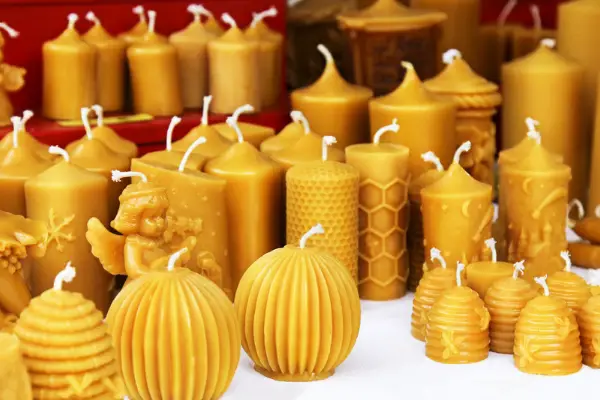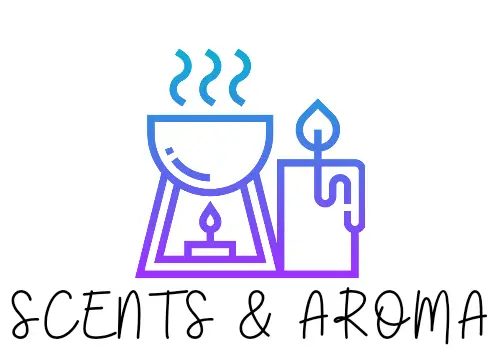Beeswax is amazing stuff. It’s the natural wax made by honey bees and so is 100% natural. Since prehistory, it has been used as a lubricant, a plastic, a polish, an ingredient in cosmetics, and of course, for making candles.
One thing you might have heard is that beeswax has air-purifying properties and if there is one thing we love here at Scents and Aroma, it’s a clean burning candle.
So, do beeswax candles clean the air? Incredibly beeswax candles when burnt actually do clean the surrounding air. They do this by releasing negative ions that bond to pollutant molecules around your home. So not only are beeswax candles great for the environment they are great for your health too.

Lets’s look in more detail at the wonderful gift from nature that is beeswax.
What is beeswax?
Unlike other waxes, beeswax is not artificial. Even other natural waxes like soy wax require production and modification.
Beeswax, though, is made by worker honey bees. In these bees’ abdominal segments, they have wax-producing glands. The wax forms into scales, and the worker bees discard the wax at or in the hive.
Hive workers collect this substance and use it to store honey. Initially, the wax is colourless and clear, but it becomes opaque once the hive workers have chewed it and mixed it with pollen.
Chemically speaking, beeswax is made up of fatty acids and long-chain alcohols. It is actually edible too and is used in foods with the E number E901.
Beeswax is often softened by diluting it in vegetable oil or mineral oil to make it workable at room temperature. It’s also sometimes clarified by heating it in water as it contains impurities from the hive.
Beeswax cleans the air
When you burn a paraffin candle, you’re burning something that is a product of fossil fuel – and we all know how bad these are for the environment. In addition, with paraffin candles, toxins and carcinogens are released into the atmosphere.
So essentially, if you’re in the same room as a burning paraffin candle, you’re breathing in harmful substances that, over time, could affect your health.
Conversely, beeswax is an entirely natural product that releases no toxins or harmful substances into the air. The great thing about beeswax candles, though, is not just that they don’t release toxins, but they actually also clean the air too.
Have a look at this helpful guide to the different types of waxes to learn more about their positives and negatives.
Negative Ions in Beeswax
Like lightning bolts, beeswax candles produce negative ions when they are burned. Negative ions are great because they attach to positive ions like toxins, odours, mould, pollen, and dust particles that float in the air.
Beeswax is the only candle wax that has the ability to remove pollution from the air and clean the air.
What is a negative ion?
A negative ion is a charged molecule created when a molecule in the air has broken apart due to movement, radiation or sunlight.
The number of negative ions depends greatly on where you are and the type of place you’re in.
For example, there are around 100,000 negative ions for each cubic centimetre in Yosemite Falls. However, in your home or office, you might have between zero and one hundred.
What do negative ions do?
Negative ions are good for relieving stress, boosting levels of alertness and energy, and reducing the number of dust mites or dander in the air. Some people believe they may also protect us from airborne contaminants.
The theory is that when the negative ions lock onto the positive ions like dust, they become heavy and fall to the floor, which allows us to clean them up.
No one knows exactly why these negative ions have such a positive effect. Still, theories suggest that they cause biochemical reactions to increase serotonin levels in the body.
Other theories include increasing oxygen flow to the brain and stimulating the pituitary gland, which is responsible for regulating the adrenal and thyroid glands.
Other reports of the benefits of negative ions include:
- They increase our mental clarity and sense of well-being.
- They’re a natural anti-depressant, especially for people affected by Seasonal Affective Disorder.
- They improve your breathing rate, relieve tension, and decrease blood pressure. Evidence also suggests they deal with free radicals in the body too.
- They improve your sleep by normalising levels of serotonin in your brain.
- They reduce the occurrence of headaches.
The history of beeswax in candle making
Centuries ago, the majority of candles were beeswax. Over the years, these were replaced gradually by tallow candles (candles made from animal fats).
Then, during the last 100 years, a new candle wax was discovered, which overtook all of the other types of wax: paraffin.
With the discovery of paraffin and its combustible properties, its popularity for candles took off. But, unfortunately, this was before it was discovered how bad petroleum-derived substances are. And, being derived from a fossil fuel, it comes with many environmental issues too. Many mass produced modern day candles such as Yankee candles are still produced with paraffin wax, even though we now know its bad for the environment and our health.
Now the issues are known, things are slowly beginning to change, and people are looking for more natural waxes to use in their candles – hence a rise in the popularity of beeswax again!
Why are beeswax candles better than paraffin?
When you burn a paraffin candle, there is smoke and soot, as well as the carcinogens and toxins we’ve already mentioned.
Plain paraffin, being a petrochemical, smells bad when it is not fragranced, which means that candle makers add synthetic fragrance oils. Some of these are toxic too.
Breathing in the fumes of a paraffin candle is akin to breathing diesel fumes.
This smoke and soot will also get on walls and furniture etc., and will recirculate in the air for a long time, even when the candle has been blown out.
Be careful when choosing your beeswax candles
So, the evidence is clear: stay away from paraffin and head to a store that sells beeswax candles. Then, instead of breathing in fumes, you’ll actually be breathing in cleaner air.
However, don’t just read the initial label of the candle and put it in your basket. Be aware that to be labelled as a beeswax candle, it only has to be 51% beeswax. The other 49% could even be paraffin or some other wax that is not as good as beeswax, and that certainly won’t be cleansing.
The cost of beeswax candles
Compared to paraffin candles, beeswax ones might seem a little expensive. However, you need to look at the health benefits of burning beeswax candles over paraffin ones. You really can’t put a price on health!
What’s more, beeswax actually burns a lot slower than paraffin, so even though the candle might be more expensive, you will actually get more burn time for your money!
It’s no wonder that beeswax is on the dearer side: to make one pound of beeswax, the worker bees need to consume ten times as much honey!
Final thoughts – do beeswax candles clean the air?
We once used them all the time, but then technology (& fossil fuels) took over, and beeswax candles were left on the shelf. Now though, people are starting to look for natural alternatives to paraffin candles and are rediscovering the wonderful properties of beeswax.
So, do beeswax candles clean the air? Yes It seems so! And even if they didn’t, they’re much nicer to burn than paraffin candles any day!
- Can You Put Perfume In A Humidifier? (Read First) - September 17, 2022
- Can You Put Essential Oil In A Steam Mop? (Safety Advice) - September 17, 2022
- How To Make Lavender Oil At Home ( Candles And Diffusers) - September 9, 2022
